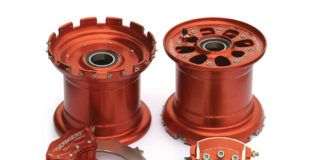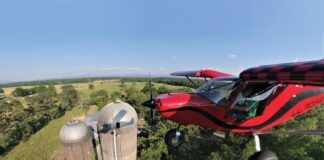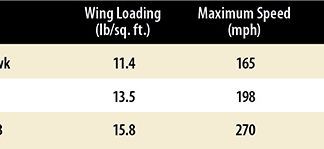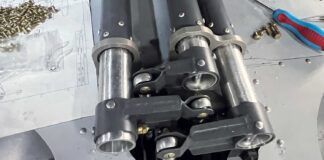It all comes down to this. Clearing the tree line at the edge of the newly mown grass strip, the Texas Cub descends smartly at 60 mph indicated, throttle nearly against the idle stop. On the turn from base to final, you set trim with a hand crank that would have, in a 1950s Buick, closed the window.
Carb heat on, mixture forward, check your wind correction angle over the nose—no flaps to put down—you’re done inside the cockpit. Procedure gives way to experience and intuition.
Finesse the Cub down the last few inches, gently hoist the nose up into the landing attitude, make small but positive corrections for the wind, and wait. For pilots accustomed to screaming down final at highway-or-better speeds, the Cub seems to be taking its sweet time, allowing wind to play with it, making busy-hands pilots feel like they should be doing more.
Soon enough, though, it sets down. If you’ve been attentive, the Cub tracks straight down the turf strip, and seems to wait for you to find the heel brakes—even then, by the time you, Mr. Toe Brake, have swiveled your heels inboard, there’s little need. Kick the rudder around, and back up a bit for another go.
After you glance up into the left wingroot to recheck elevator trim and advance the power, you might have time, between the surprisingly hard push forward on the stick required to raise the tail and commencement of the subtle rudder dance needed to keep the Cub on track, to peek at the Dynon engine monitor to see if the Mattituck-built Continental O-200 is hitting on all four. You might, but the Cub wants to get flying and will by that time have left terra firma, as flecks of grass sliding off the still-spinning mainwheels are visible through open doors on both sides of the cabin. Go around the pattern and do it again. Because, very simply, it’s that much fun.
Cub History, Like You Don’t Know It
The Cub remains dauntingly popular. Whether you’re a fan of the original C.G. Taylor design of 1930 or the postwar J-3 that became the de facto trainer of the day, the Cub manages to remind of simpler times. It had good performance, perky good looks and was comparatively docile.
Moving ahead half a click on your time-travel dial to 2005, we find the American Legend Aircraft Company showing a good performing, perky, docile Cub to the world and discovering that, against a host of Light Sport Aircraft competitors, the new Cub was once again a sales benchmark. The same pilots who started flying in Cubs were ready to trade their Bonanzas and Vikings in for a last fling with their first love. That they would gladly plunk down $100,000 or so—$123,000 with every option box but floats checked—raised more than a few eyebrows.
Now, Do It Yourself
Demand for the SLSA Legend Cub was strong, but those of more modest means began asking for a kitted version of the airplane in hopes of coming in under the Spousal Pain Threshold.
Legend Aircraft General Manager Kurt Senhert says, “We started with the SLSA airplane, and one of the first questions was, ‘Are you going to make a kit?’ We believe in doing one thing well, so we concentrated on the SLSA. We wanted to get that right, so we wouldn’t put a time frame on [developing the kit].”
Now’s the time in part because the demand has ratcheted up for the Experimental/Amateur-Built version, but also,
bluntly, because sales of the SLSA had begun to slow. Industry watchers believe this turn of events—remember that American Legend sold more than 50 aircraft the first year—has to do with the economy in general and market saturation of this kind of airplane. Not the Cub’s fault.
Kitting a production aircraft is not easy, despite having all the pieces in the shop. “We know every nut, bolt, washer, clevis and cotter pin that it takes to build this thing,” says Senhert. “From the packaging side, we’d like to advertise that you get every last bit of hardware you need to build it. We’re going to wait until 10 guys build the kit before we make the claim. It only takes one missing washer before someone says that claim is false. It’s a lot of work to make a kit.” Training in house makes for suitable process control on the SLSA, but that control has to be taken outside for the kit, something Senhert and his crew spent considerable time working out.
Moreover, they need to create a manual for the rest of us, because the way an American Legend Cub goes together with professionals will be different in myriad ways from the process ideal for an individual. “We worked very hard on the manuals,” says Senhert. After a lengthy perusal of the manuals at the factory, we have to say they’re top notch, with clear, concise directions, and ample photos and illustrations.
Experimental vs. SLSA: What’s the Diff?
Believe it or not, precious few items distinguish the Texas Sport kit from the production-line American Legend Cub. The floorboards are fire-resistant composite in the SLSA, and the cowling is different. Minor component choices and different paperwork tracking round out the list. For all practical purposes, they’re the same airplane.
In many respects, the Texas Sport Cub represents a true hybrid of old and new. Big stuff, like the blunt-nosed USA-35B airfoil (not a Clark-Y as is often reported) that makes up the big wing and the steel-tube structure are very close in intent if not execution to the stalwart Piper products. The Continental O-200 is likewise a none-too-distant cousin of the C-series powerplants that proved to be the most popular in the postwar Cubs.
The Texas Sport Cub itself follows the American Legend Cub’s SLSA form, including the choice of the Continental O-200 or the Jabiru 3300 (120 horsepower, cheaper and lighter to boot), an open cowling with the American four-banger—closed as an option for the O-200 and the Jabiru—a widened cabin and split folding doors left and right. Original Cubs had a split door on the right. It’s delightful to open both doors and windows in flight during the summer, but it’s slightly more pleasant with the left side lower door closed.
Better yet are the improvements brought by the 3-inch-wider fuselage frame. In fact, that increase seems small on paper but is, in terms of perception, huge in the real airplane. Moreover, the Legend Cub/Texas Sport Cub are both widened the entire length of the cabin, so the front seat now feels about right and the back seat generous in most dimensions. Still no adjustable seats, so make your cushions to fit; and make the pilot’s seat for the front, where you’re now expected to solo the airplane.
Structurally, the Texas Sport is modern. During construction, a massive jig joins the 4130 steel tube with CNC machined “fishmouth” joints. Each tube fits precisely against its mate, an impressive sight where a big cluster of tubes comes together. The cage is tack welded in the jig and then taken over to a separate MIG station for final buildup. The cage is strategically stronger in places, particularly across the roof, where a cross brace replaces the through-the-skylight wingspar arrangement used in the true J-3s.
Elsewhere, the wings are built up using an aluminum spar whose capstrips create an E section; the ribs are stamped aluminum. Square steel tubes crisscross the interior of the wing to help stiffen it. The wing is hung from fore and aft lugs outboard of the fuselage proper and held at station by a pair of actual FAA-PMA lift struts. The wing is fully assembled structurally, ready for installation of the dual 11-gallon fuel tanks—a total of 20 gallons is usable—control cables, pulleys and various brackets and wires. Then you cover it—the factory offers AirTech or Stits systems.
Legend Aircraft has a builder-assist program called KwikBild. It starts with a 14-day program that gets the airframe through covering, which also includes installing and testing some systems. Then you can leave while the airplane is being painted, either at the factory or elsewhere. Another seven-day program takes the painted airplane up to taxi tests; combined, you get a 21-day program with a gap in the last third for painting. Total cost, exclusive of the paint is $9000. You can do either end of the program.
Other Differences, or Why
Experimentals Rock
Naturally, the Texas Sport Cub is a close cousin to the SLSA, but there are some critical advantages. First is that you can certify the Sport Cub at 1600 pounds maximum gross weight, up from the LSA limit of 1320. Given the typical empty weight nearing 870 pounds, that’s a fine improvement in useful load, from around 333 pounds to 613. In the LSA, two standard-weight pilots would have to leave some fuel behind and carry no baggage, but in the Experimental there’s payload to spare. (Remember that if you build a Texas Sport Cub and “certify” it to the higher gross weight, it cannot go back and become an LSA. Ever.)
Next on the hit parade is maintenance—you, the builder, can do everything on the Experimental, no classes necessary. Plus you have considerable liberties in the choice of components, radios, lighting, etc. Seems like a no-brainer to us.
Back to the Flying
Enough about the business. More about the fun. The Texas Sport Cub is, in every way we can detect, simply a Cub done smart. Flying qualities are classic Cub—actually, better. This version uses the counterbalanced rudder but the plain elevators of the early Piper Cubs, so pitch forces are moderate. Trim stability is excellent, and with two aboard there’s sufficient stabilizer travel—that’s how you trim it, not with moveable tabs—to allow hands-off flying at approach speeds and below.
Better, did we say? Yes, because the Texas Sport (like the American Legend) with 2° of dihedral has less adverse yaw than a true Cub and is willing to pick up a wing with rudder, no problem. Control harmony is good, but it’s still a rudder airplane—not as trying as a sailplane, but not as resolute as many designs.
Checking performance in a Cub is, well, pretty much academic. With just 100 hp up front, a massive amount of flat-bottomed wing (try 179 square feet) and few attempts at drag reduction, the Cub’s claimed 83-knot (95 mph) cruise is really no surprise. We tried to verify cruise performance at higher, more optimum altitudes, but Senhert, from the back seat, jokingly suggested that, “The Cub’s warranty runs out at 6000 feet.” We saw 97 mph TAS on the Dynon EFIS-D100 in the demonstrator Cub at a density altitude of 3000 feet. Turning 2500 rpm, the little Continental was taking in 6.3 gph at a full-rich mixture, according to the fuel-flow reading. Combined with a sub-3-hour endurance with reserves, the Cub’s cruise performance leaves you making many landings to cover great distances; true of the J-3, true of the Texas Sport.
Do you care? This is about flying low over open land at sunset. Seeing your town from 1000 feet AGL. Perfecting those takeoffs and landings after work during those long days of summer.
Like the J-3, the Texas Sport Cub is flawed. It’s not fast, and the low wing loading causes it to be it fairly uncomfortable in atmospheric conditions you might call ticked off. Even in its improved state, the Cub will win no awards for creature comforts. You will, on occasion, look like a complete oaf trying to get in and out.
But, but…it also makes you think about flying when you should be working. It causes you to go to the hangar instead of fixing Aunt Maude’s garden gate. You fly with your eyes outside the cockpit, reacquainted with the wonder of flight. Now, you lucky dog, you can build one for yourself.
For more information on the Texas Sport Cub, call 866/746-6159 or visit www.txsport.aero. A direct link to the manufacturer’s site can be found at www.kitplanes.com.





